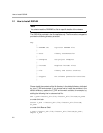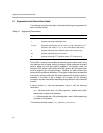
Using DSPLIB
2-3Installing and Using DSPLIB
2.2 Using DSPLIB
2.2.1 DSPLIB Arguments and Data Types
2.2.1.1 DSPLIB Types
Table 2−1 shows the data types handled by the DSPLIB.
Table 2−1. DSPLIB Data Types
Name
Size
(bits)
Type Minimum Maximum
short 16 integer −32768 32767
int 32 integer −2147483648 2147483647
long 40 integer −549755813888 549755813887
pointer 32 address 0000:0000h FFFF:FFFFh
Q.15 16 fraction −0.9999694824... 0.9999694824...
Q.31 32 fraction −0.99999999953... 0.99999999953...
IEEE float 32 floating point 1.17549435e−38 3.40282347e+38
IEEE double
64 floating point 2.2250738585072014e−308 1.7976931348623157e+308
Unless specifically noted, DSPLIB operates on Q.15-fractional data type
elements. Appendix A presents an overview of Fractional Q formats.
2.2.1.2 DSPLIB Arguments
TI DSPLIB functions typically operate over vector operands for greater
efficiency. Even though these routines can be used to process short arrays, or
even scalars (unless a minimum size requirement is noted), they will be slower
for those cases.
- Vector stride is always equal to 1: Vector operands are composed of vector
elements held in consecutive memory locations (vector stride equal to 1).
- Complex elements are assumed to be stored in consecutive memory
locations with Real data followed by Imaginary data.
- In-place computation is not allowed, unless specifically noted: Source
operand cannot be equal to destination operand.


















